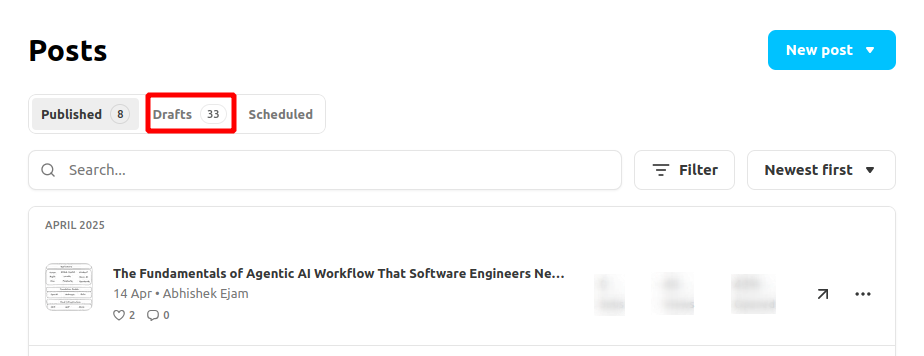5 Proven Ways To Overcome Writer's Block
What I learned during my longest creative block (and how you can skip the pain)
Six weeks.
That's how long I stared at blank screens, started and abandoned drafts, and watched my publishing schedule fall apart. I know that I’ve committed to writing at least one long-form article every two weeks.
But writer’s block had me completely paralysed.
This is a newsletter related to software development. You may be thinking about why I’m writing about the writing. Yes, you're right. But here's the thing: whether you're writing code documentation, technical blog posts, or debugging comments, every developer writes. And every writer hits walls.
I'm sharing this breakdown not just to get back on track, but because I know some of you face the same creative paralysis. Consider this my rubber duck debugging session, but for writing instead of code.
What Writer's Block Feels Like
It’s not laziness or lack of discipline. It’s sitting down to write and opening your computer (or notebook), but you can’t come up with ideas and produce/complete the essay. Your brain throws a 404 error.
For me, the main problem was not sticking to one topic long enough. As soon as I started writing, I felt like the topic was not good enough for writing. So I chase another topic to write. And just like that, I wasted 6 weeks.
As you can see, I’ve 4 times more drafts than the actual articles I’ve published in the Substack dashboard.
But those 6 weeks weren't wasted. I discovered 5 systems that actually work through research, painful trial and error, and way too much green tea.
Let’s dive right in!
1. Separate idea generation from evaluation
As I look back, I noticed that I didn’t have separate idea generation sessions. I used to brainstorm topic ideas on a Saturday afternoon. Then, I start writing on the topic asap — only to realise later that either I’m not interested in the topic or don’t have enough experience to talk about it.
Therefore, I found out that it is ideal to dedicate a separate ideas generation session. The main goal of the session is to list potential topics that meet the following three criteria:
Am I genuinely interested in the topic?
Do I have real experience with it?
Will this help someone solve an actual problem?
The session can be limited to 30 - 60 minutes to list potential ideas without judgment. After the session is over, you will have at least 10 - 15 topics. But don’t just pick one topic and jump into writing on it instantly. Wait for at least a day to decide on which one to pursue. This would give enough time to be certain about the topic that you will write about, so you won’t chase newer topics.
2. Commit to completion, not perfection
The shitty first draft approach
The original idea of the shitty first drafts approach was created by Anne Lamott in her book Bird by Bird. The main goal of shitty first draft is to write the first draft with the goal to completion, not perfection.
Here’s an excerpt from the post:
Almost all good writing begins with terrible first efforts. You need to start somewhere. Start by getting something -- anything -- down on paper. A friend of mine says that the first draft is the down draft -- you just get it down. The second draft is the up draft -- you fix it up. You try to say what you have to say more accurately. And the third draft is the dental draft, where you check every tooth, to see if it's loose or cramped or decayed, or even, God help us, healthy.
Just like Test Driven Development (TDD), the goal is not to write the cleanest code at first. The goal is to just make it work and refactor it later. Likewise, the shitty first draft would help to create a momentum and put down your thoughts on paper (or computer). Come back to it on the second and third drafts for refinement.
Set a completion goal
The only way to become a good writer is to force yourself to produce a certain number of words daily. William Zinsser talks about this idea in the book On Writing Well.
So, while writing the shitty first draft, set a goal to produce at least 100 words daily or 800 -1000 words weekly regardless of the quality. You can just write whatever things that come to your mind (about the topic) and produce the desired word count. That’s it.
3. Create external accountability
Writing buddy
I participated in a writing challenge a few months back where the goal was to post daily on social media platforms. I was surprised that my writing habit and creativity spiked during the challenge.
The improvement was mainly due to the accountability partner I had in the challenge. They used to post daily, which motivated me to write too. I wrote 24 notes on Substack in that month — my most consistent streak ever. And, it also helped to create momentum to post daily on social media.
Public commitment
Another way to create external accountability is to make a public commitment on social media. I’ve learned this in a Reddit thread, and it works.
As you can see, I’ve made an announcement on Saturday about publishing this article on X. And here I am, in your email inbox. Social pressure works.
4. Don’t start on a blank page
Develop the structure of the article
Writers aren’t painters, so a blank canvas isn’t our friend.
One of the main reasons you may hit writer’s block is that you start on a blank page. I used to do it a lot in the past, but I’ve learned not to do it from a writing course.
Develop the skeleton or structure of the article first. After that, you just fill in the section with your thoughts. It’s just like using a framework instead of building the app from scratch.
Build a knowledge management system
Knowledge management systems are the easiest way to capture ideas and pull them when you hit writer’s block. You may have already been using the Apple Notes app to add the grocery list before you go shopping, like me. You can use the same app to capture ideas you find on the web or your thoughts as they pop up during the day.
If you want to go advanced, try Notion, Obsidian or Roam research. They are great for capturing and organising ideas. The best one depends on whatever creates the least resistance in capturing your ideas. But the important thing is to fall in love with the process, not the tools.
5. Reframe your thinking
Topics aren’t good or bad
It took me almost a year to understand this, but topics are not good or bad in themselves. So jumping from one topic to the next in search of finding best one only adds more resistance to your writing process.
Headlines are, of course, important, which is a totally different topic. But, in regards to writing, your unique take on the topic matters more than the topic itself. I’ve learned after analysing several posts on Substack. So, bring your unique perspective to the topic instead of chasing the next shiny topic.
Write for one person
Know thy audience! Yes, when you know who you are writing for, the writing becomes less blurry. For example, I know that this post is going to be helpful for those who get stuck in writer’s block. So I’m trying to help them by answering the top 5 things that cause writer’s block.
It’s just like rubber ducking programming, where you explain your code line by line to non-living objects. While doing so, you gain clarity about the code. In short, the words flow more easily when you know your audience.
A few bonus tips
Apart from these 5 ways to beat writer’s block, there are a few additional tips that I find helpful:
Take a break - Sometimes, the most interesting idea comes when you go on a bathroom break. So take those breaks throughout the writing session.
Build the system/surrounding to promote writing - James Clear suggests in the book Atomic Habits that you need a good system to promote habits.
You do not rise to the level of your goals. You fall to the level of your systems
Therefore, ask yourself, “What’s one thing you can do that makes you write more?” I keep my notebook on my study desk in the living room, where I often see it, which motivates me to write more.
Don’t try to write everything in one session - It’s difficult to write a long-form post in one go. So it’s helpful to break the process into multiple sessions. For example, you can allocate 1 hour focus block daily to write:
Monday and Tuesday for ideation
Wednesday for writing the structure of the post
Thursday and Friday for writing the content
Saturday for review and refinement
The Meta Lesson
This post exists because I stopped trying to write the "perfect" piece and started with "good enough to help someone." Sometimes the most valuable content comes from our struggles, not our successes.
Writer's block isn't a character flaw, but it's a system problem. If you fix the system, the words will follow.
Thank you for reading and supporting this newsletter 🙏. You can hit the like ❤️ button at the end of this post to support my work. It means a lot to me!





